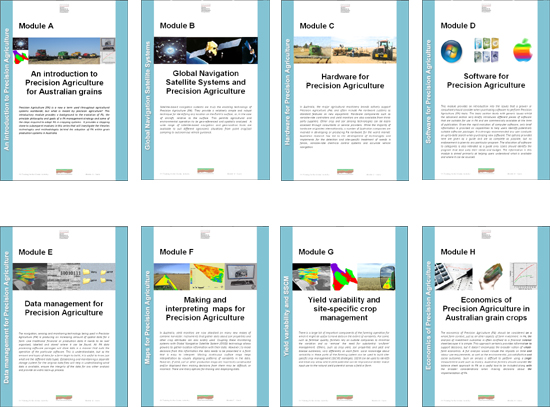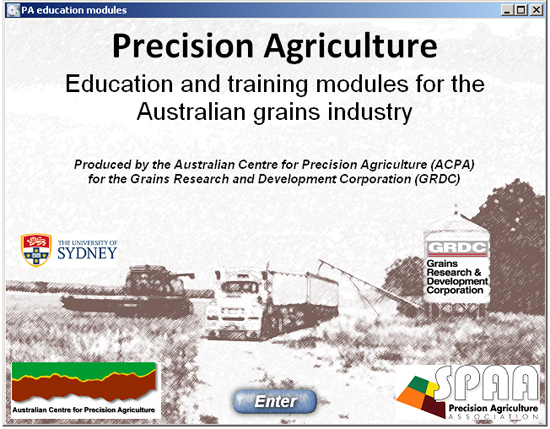These resources were produced as part of a collaboration between ACPA and GRDC. The PA Lab continues to make them available for widespread use in the agriculture and education sectors as an output from the GRDC National Strategic Initiative on PA (SIP09) and the Next Steps in PA program.
The History of PA in Australia
Precision Agriculture (PA), in its current form, has a long history of innovators and pioneers with a single aim of improving agricultural management. Australia remains at the forefront of the development of PA tools and practical applications, not the least because of our unique range of production conditions.
Undoubtedly the application of PA continues to be a general success in Australia despite the fact that some products or techniques have not been adopted or remain ahead of their time.
Development opportunities are naturally opening in areas which better quantify small-scale variation and allow such information to be usefully integrated into management decisions. Sensing systems, analytical procedures, software, agronomic understanding, robotics, human resources will all provide areas for PA to continue the transformation of agricultural management into an increasingly resource efficient, less risky, societal endeavour.
View A Review of the History of PA in Australia and some future opportunities (24.7MB).
It is a presentation that outlines the significant developments in Australia. As a caveat, it could be considered grain-centric and, no doubt, incomplete.
21 Steps to PA in Australia
A decision tree which requires a positive or negative answer to decide on an individual incorporation path. A Plan for Incorporating Precision Agriculture into Australian Farm Management has been devised to assist Australian farmers. It begins with the decision whether to move into some form of vehicle navigation aid. While the use of vehicle navigation aids is generally recommended as the initial step, the use of the later stages of the plan do not necessarily require such systems (e.g. small farm size and turnover may preclude such initial purchases but not the possibility of improving management of variability).
Site-Specific Crop Management (SSCM) for Australian Grains: How to Begin
A simple explanation of the processes that may need to be considered in the introduction of SSCM in Australian grains. SSCM needs to be tailored to individual farms and fields, but a general plan to help choose the options that best fit local conditions and situations is supplied here.
Precision Agriculture: Education and Training Modules for the Australian Grains Industry

Rationale for the modules
These modules have been developed for the GRDC in response to an identified need for information on Precision Agriculture (PA) tools and techniques to be made more widely available to graingrowers and others in the grains industry. The development process has been mindful of the great variety of existing PA knowledge levels and information requirements within such a diverse industry. To this end, the modules were designed to be interacted with at multiple levels to suit the skills and needs of different target audiences (growers new to PA, advanced growers, advisors, dealers, technology manufactures etc.).
Format of the modules
The education and training modules have been compiled to provide information on the major topics considered relevant to adopting PA in the Australian grains industry. They are intended to be a resource for individual education, for use in developing training workshops or combining with established training materials. Each module focuses on a particular PA subject area and is delivered in up to four sections:
- Basic information – an overview of the important topics in the subject;
- Advanced information – a more comprehensive treatment of the subject including expanded detail on the important topics;
- FAQ – common questions, exercises and handy tips; and
- Supplementary information and archive – reference material to provide further detail or background knowledge if required.
Individuals can delve to the level of detail they require from each module. Training coordinators can choose the combination of subjects, specific topics and appropriate level of information in each to suit the knowledge of the trainees and the specific goal of a training program. The material in the Basic, Advanced and FAQ sections is provided in ‘open access’ form. The text, figures and tables can be freely extracted and used in other presentation formats.
Accessing the modules
The modules are provided individually here with the image content in a compressed form. The total download for the set is 127 MB. A full resolution set on autorun CD can be obtained by contacting the PA Laboratory

Module A – An Introduction to Precision Agriculture for Australian Grains
Precision Agriculture (PA) is a now a term used throughout agricultural systems worldwide; but what is meant by Precision Agriculture? This introductory module provides a background to the evolution of PA, the principle philosophy and goals of a PA management strategy and some of the steps required to adopt PA in cropping systems. It provides a stepping stone to subsequent modules in this series that will investigate the theories technologies and methodologies behind the adoption of PA within grain production systems in Australia. Download (1.3MB ZIP)
Module B – Global Navigation Satellite Systems and Precision Agriculture
Satellite-based navigation systems are truly the enabling technology of Precision Agriculture (PA). They provide a relatively simple and robust technique for identifying any location on the Earth’s surface, or, in the case of aircraft, relative to the surface. This permits agricultural and environmental operation to be geo-referenced and spatially analysed. A wide range of satellite-based navigation and geo-location tools are available to suit different agronomic situations from point crop/soil sampling to autonomous vehicle guidance. Download (22MB ZIP)
Module C – Hardware for Precision Agriculture
In Australia, the major agricultural machinery brands actively support Preciaion Agriculture (PA) and often include PA hardware systems as standard features on new equipment. Hardware components such as variable-rate controllers and yield monitors are also available from third-party suppliers. Other crop and soil sensing technologies can be easily accessed through consultants or service providers. While the majority of hardware originates internationally, a number of Australian companies are involved in developing or producing PA hardware for the world market. Australian research has led to the development of technologies and implements for the detection and site-specific treatment of weeds in fallow, variable-rate chemical control systems and accurate vehicle navigation. Download (34MB ZIP)
Module D – Software for Precision Agriculture
This module provides an introduction into the issues that a grower or consultant should consider when purchasing software to perform Precision Agriculture (PA) tasks. The basic section deals with generic issues whilst the advanced section very briefly introduces different pieces of software that are suitable for use in PA and are commercially available at the time of publication. Given the rapid evolution of computer software, only brief information is provided on capabilities to help users identify potentially suitable software packages. It is strongly recommended any user conducts an up-to-date search when purchasing new software. The options provided here are given as a guide and are as complete as possible, but no endorsement is given to any particular program. The allocation of software to categories is also intended as a guide only. Users should identify the program that best suits their needs and budget. The information in this module is aimed primarily at helping users understand what is available and where it can be sourced. Download (2MB ZIP)
Module E – Data Management for Precision Agriculture
The navigation, sensing and monitoring technology being used in Precision Agriculture (PA) is producing an increasing amount of spatial data for a farm. Like traditional financial or production data it needs to be well organised, labelled and stored where it can be found. All PA data processing software packages will store data in a manner that suits the operation of the particular software. This is understandable, but as the amount and types of data for a farm begin to build, it is useful to know just what are the different data types. Establishing and maintaining a separate storage system for the original data files will help in understanding what data is available, ensure the integrity of the data for any other analysis and provide an extra back-up process. Download (1.3MB ZIP)
Module F – Making and Interpreting Maps for Precision Agriculture
In Australia, yield monitors are now standard on many new makes of combine harvester. Instruments that gather data about soil properties and other crop attributes are also widely used. Coupling these monitoring systems with Global Navigation Satellite System (GNSS) technology allows growers to gather location information with their data. However, to make decisions from this information the data needs to be presented in a form that is easy to interpret. Making continuous surface maps helps interpretation by visually displaying patterns of variability in the data. However, if yield, soil or other production maps are incorrectly constructed and/or displayed then making decisions from them may be difficult, or incorrect. There are many options for making and displaying data. Download (22MB ZIP)
Module G – Yield Variability and Site-Specific Crop Management
There is a large list of important components of a farming operation for which it might be useful to have data on the extent of variability. For some, such as fertiliser quality, farmers rely on outside companies to minimise the variation and so ‘remove’ the need for substantial ‘on-farm’ management. Others, such as crop yield, soil properties and pest and disease outbreaks, vary differently on each farm. Local knowledge about variability in these parts of the farming system can be used to build site-specific crop management (SSCM) strategies. SSCM can be used to identify and treat any areas where yield potential can be improved or better match input use to the natural yield potential across a field or farm. Download (7.5MB ZIP)
Module H – Economics of Precision Agriculture in Australian Grain Crops
The economics of Precision Agriculture (PA) should be considered in a whole farm context, just as all other aspects of farm investment. In PA, the analysis of investment outcomes is often confined to a financial balance sheet because it is simple. This approach certainly provides information to support decisions, but it doesn’t encompass the broader notion of whole-farm economics. A full analysis would include the impacts on time and labour use requirements, as well as the environmental, job satisfaction and social outcomes. Such an analysis is difficult to perform using a single measurement scale such as money. Australian farmers should consider the balance sheet approach to PA as a useful tool to be included along with broader considerations when making decisions about the implementation of PA. Download (36.5MB ZIP)
